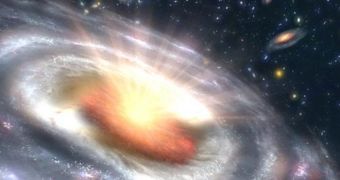It is believed that hydrogen was the most frequent element found in the early universe, not long after it formed as a result of the Big Bang explosion. But a new study surprised scientists by indicating that it might yet not be so. The research focused on the observation of very distant galaxies formed during the youth of the universe, located some 11,5 billion years away from the Earth, and collected data showed that their hydrogen content is extremely low compared to the expectations. The experts hold black holes and their subsequent quasars responsible.
A team led by Steve Curran, from the University of New South Wales in Australia, spotted the 11,5 billion-year-old galaxies by means of the Giant Metrewave Radio Telescope in India. But due to light's traveling speed and the enormous distance, the galaxies are depicted as they looked back then, namely "only" 2 billion years old. Since the process of star formation requires vast amounts of hydrogen, they predicted to be able to see massive quantities. But the discovery proved otherwise.
"Since hydrogen gas is consumed by star formation, we may expect more hydrogen gas in the distant, and therefore earlier, universe," reported Curran in a press release, cited by Wired. But what they observed was a very bright light possibly emitted by the quasars in the middle of the galaxies, which, they believe, causes the disappearance of hydrogen. They only leave behind a plasma made of free ionized particles, undetectable in the radio frequencies used.
"At such distances, only the most optically bright objects are known. The intense radiation from the matter accreting into the black hole in these quasars is extreme and we believe that this radiation is ripping the electrons from the atoms, destroying the hydrogen gas," explained Curran. The increased presence of the quasars in the oldest galaxies (or youngest, as they appear to us) may explain their lack of hydrogen. What the study did not explain, though, was where the hydrogen needed for star formation came from later on during the galaxies' lives.

 14 DAY TRIAL //
14 DAY TRIAL //